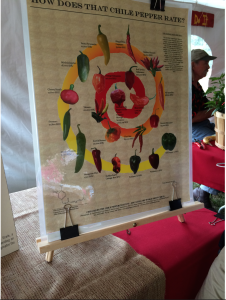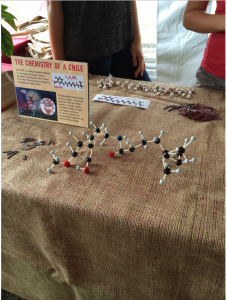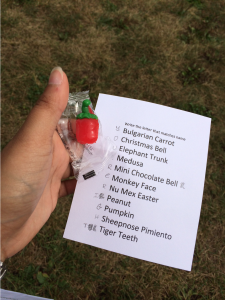Prior to attending Saturday’s Pepper Party at the Plantations (the alliteration was intentional), I have to admit, my pepper vocabulary was limited to say the least. Spicy peppers, sweet peppers, and maybe the occasional jalapeno peppers on my pizza. But I’m not going to sit here and tell you that I learned everything about peppers within the hour I spent walking around the field. I can tell you, though, I got to try some great food, meet some great people, and find out some great things I didn’t know before.
Early on, I went to a booth where they spoke solely to the chemistry of the pepper. (I have to tell you, chemistry is my absolute favorite subject, so the fact that there were people here talking just about chemistry made me happier than you can imagine.) Capsaicin, pictured below, is the predominantly active molecule in peppers; the more capsaicin, the spicier the pepper. It turns out that it’s actually kind of hard to measure the amount of capsaicin in a pepper, so how they ranked peppers before the technology was developed was essentially a taste test. They’d soak peppers in water and ask people to drink the water until they tasted the heat. Nice.
*Also, if you look really closely at the picture of capsaicin, you can see another model behind it. They were also giving out marshmallows and coffee stirrers so that we could make our own capsaicin models. As tempted as I was to accept the offer, I figured I should probably put my O-Chem model kit to use.
I also played a game. If I could correctly name 11 different peppers, I’d get a special surprise. Naturally, I was all for this. Among my favorite peppers were Mini Chocolate Bell peppers, Monkey Face peppers, and Medusa peppers (which are apparently named for the plant, not the shape of the pepper). Unfortunately I had already taken a bite of my prize by the time I decided to take a picture, but the thought is what counts.
From chocolate pepper truffles to pepper mustard to pepper gummies to fresh peppers, this pepper party was definitely hot. I had a lot of fun and I’d strongly recommend a trip to the plantations to anyone who’s thinking about it.
~Nalli Muthiah




Nalli, this is an awesome post! You taught me a great deal more about peppers than I knew before. I like that you were able to tap into your love of chemistry and make a connection to class content. As someone taking organic chemistry this semester, I can appreciate your use of the model kit and the history behind how the peppers were ranked. I would be curious to know if this is how other foods have been ranked in the past in terms of sweetness, bitterness, or other tastes.